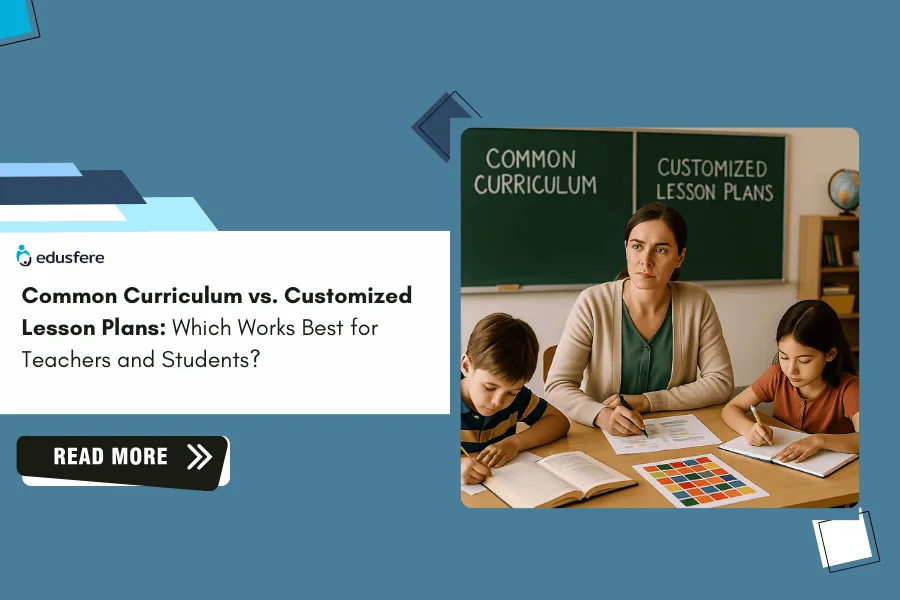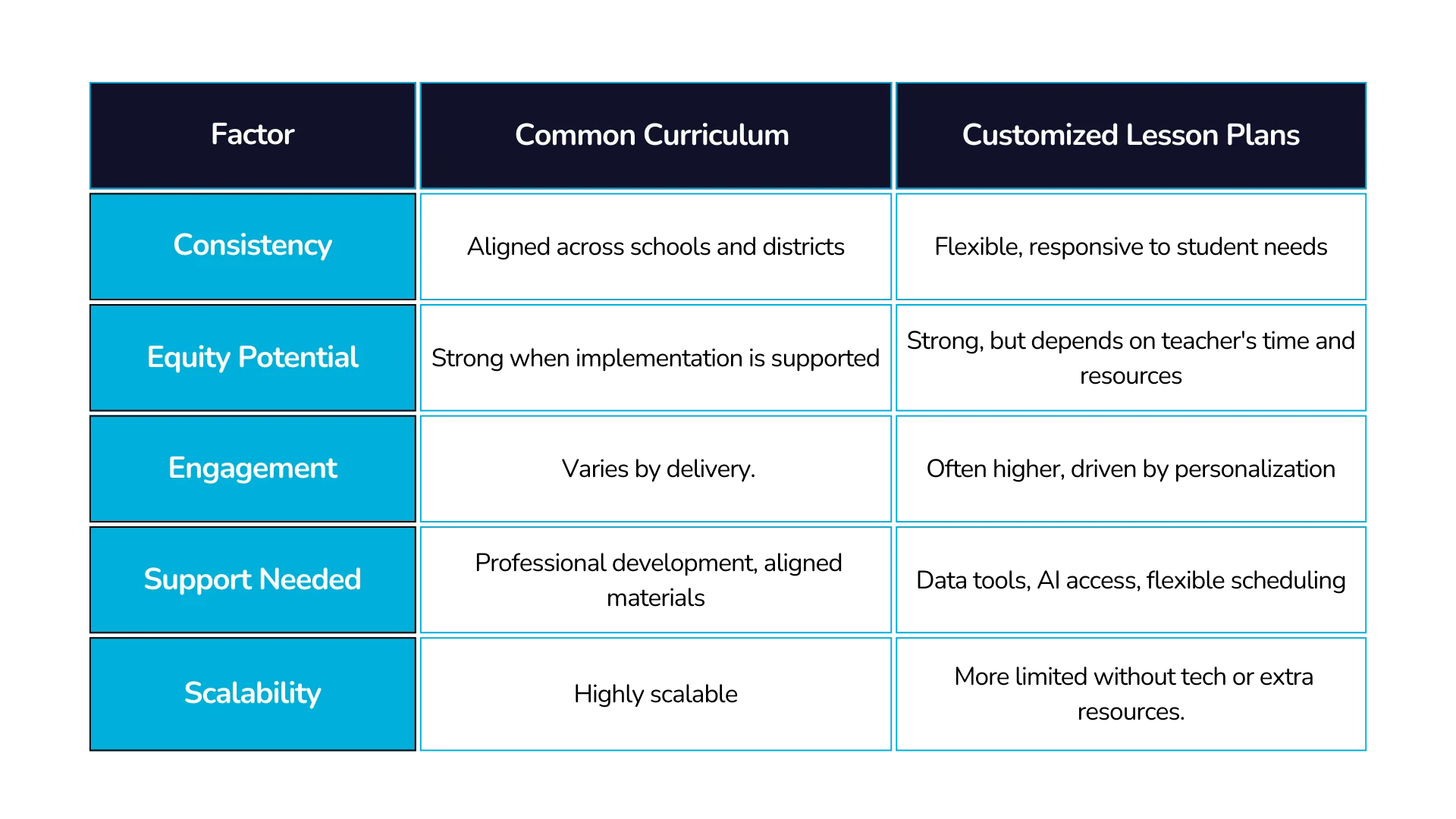Schedule a free demo to learn more
Common Curriculum Vs. Customized Lesson Plans: Which one works best for Teachers and Students?
10th Sept 2025

If you’re a teacher or school leader, you’ve probably asked yourself – should we stick with a common curriculum or give teachers the freedom to create customized lesson plans?
It’s a debate that has only intensified in recent years. With post-pandemic learning gaps, changing standards and the rapid rise of AI in education, choosing the right approach isn’t just a theoretical question; it shapes the daily experience of students and teachers alike.
Lets explore the pros, cons and future of each model to help you decide what works best for your classrooms.
What is a Common Curriculum?
A common curriculum refers to standardized frameworks of lessons, benchmarks and assessments used across schools or districts. Think of the Common Core Standards, which continue to influence how schools across the U.S. design and deliver instruction.
The idea is simple, to maintain consistency. A student in Los Angeles and one in Kansas City might be learning the same algebra concepts at the same grade level. This consistency helps with mobility and ensures that standards of learning don’t fluctuate wildly by district.
What are Customized Lesson Plans?
Customized lesson plans are tailored by teachers to meet the unique needs of their classrooms. This could mean adjusting reading material for English language learners, creating project-based science activities or integrating local community issues into lessons. Rather than rejecting standards, customization acknowledges that students learn best when instruction reflects their realities.
At Edusfere, we’ve seen schools thrive when they anchor in structure but allow flexibility for teacher-led customization.
Why do schools rely on a Common Curriculum?
The strongest argument for a common curriculum is equity. When expectations are consistent, every student has access to the same academic foundation, regardless of zip code. in 2024, 39% of U.S. fourth graders scored proficient in math, up slightly from 35% in 2022. Without common benchmarks, these gaps would likely be wider, making it harder to track national progress.
For leaders, a shared curriculum also simplifies accountability. Teachers across schools align to the same benchmarks, making district-wide assessment and reporting more manageable. But consistency comes with trade-offs. Lower-performing students often fall behind even when a curriculum is standardized. In fact, post-pandemic data show widening gaps between high and low-achieving students.
A strong curriculum framework isn’t enough on its own, it requires intentional support and teacher training to ensure no one is left behind.
How can Customized Lesson Plans improve student engagement?
Every teacher knows that students rarely fit neatly into one box. Customized lesson plans offer flexibility to adapt instruction, making learning more meaningful. And the data supports this approach:
Schools that embrace personalization report better attendance and lower dropout rates.
The real magic of customization is engagement. When students see lessons tied to their interests or life experiences, they’re more motivated to participate and more likely to retain knowledge.
With advanced tech like AI, classroom discourse has witnessed a dramatic jump from just 25% in 2023. These tools help generate differentiated practice questions, track student progress and free up teacher time.
How to choose between Common Curriculum and Customized Lesson Plans?
This isn’t a simple either/or decision. Instead, schools should weigh their priorities and capacity.
- Clarify your goals
Is your district aiming for consistency across multiple schools? Or are you focused on closing achievement gaps within classrooms? - Blend the two models
A strong common curriculum provides equity and accountability, while customized lesson plans bring the curriculum to life for diverse learners. - Invest in professional development
With 86% of U.S. districts reporting hiring challenges, it’s not enough to provide curriculum materials. Teachers need time, training and support to adapt effectively. - Review and refine regularly
Data on attendance, engagement and outcomes should inform ongoing adjustments. A static curriculum quickly loses relevance in a changing world.
Key Differences Between Common Curriculum and Customized Lesson Plans?
Here’s a side-by-side comparison to help visualize the trade-offs:

What does the Future of K-12 Curriculum Planning look like?
The future is neither rigid standardization nor full customization. Instead, it’s a hybrid model that blends structure with flexibility.
- Human & AI Blend
With the right blend of Human and AI partnership, AI can analyze data and provide tailored suggestions, while teachers bring creativity, empathy and expert judgment. - Ongoing adaptability
As student demographics, learning styles, and technologies shift, curriculum planning will need to be iterative, not static.
Which approach works best for the Modern Day Classrooms?
In a nutshell, neither model works in isolation. The most effective approach is a hybrid, anchoring learning in a common curriculum for consistency and equity, while empowering teachers to create customized lesson plans that spark engagement and meet students where they are.
This balance respects both the system’s need for structure and the classroom’s need for flexibility.
How can Edusfere help you in this endeavor?
At Edusfere, we specialize in helping schools strike the balance between a common curriculum and customized lesson plans. Our smart school curriculum planners and partnerships with curriculum providers allow educators to design curriculum lesson plans that are rigorous, flexible and data-informed.
Ready to explore how your school can bring the best of both worlds together? Schedule a demo today and let’s build strategies that serve every learner.